Mobile CPU Wars: Core 2 Duo vs. Core Duo
by Anand Lal Shimpi on August 3, 2006 9:25 AM EST- Posted in
- CPUs
The Test Platform
For today's review we compared Intel's Core 2 Duo T7600 (2.33GHz/4MB) to Intel's Core Duo T2600 (2.33GHz/2MB). The apples-to-apples comparison starts with two CPUs with identical clock speeds, but is further reinforced by the test platform: a Napa based ASUS notebook.
The ASUS Z96Js is outfitted with a 15.4" widescreen display with a 1280 x 800 native resolution, driven by a 256MB ATI Mobility Radeon X1600. Our test system was outfitted with two 512MB DDR2-667 memory modules. Unfortunately the ASUS notebook doesn't allow adjustment of memory timings so they were left at the SPD defaults of 5-5-5-15. We installed a 7200RPM Hitachi Travelstar 7K100 (60GB SATA) hard drive in the notebook, but regardless of what we use, 2.5" disk speeds are still nowhere near what's available on today's 3.5" desktop drives.
The motherboard in the Z96Js features Intel's 945PM chipset and a 479-pin Socket-M interface. Since both of our test CPUs were Socket-M processors, all we had to do was get a BIOS update to support Merom and swap the CPUs to compare the two.
Swapping CPUs is easy in the Z96Js, you get access to the memory slots and CPU socket by removing one panel on the bottom of the motherboard (as shown above). The next step is to remove the heatsink which is shared between the CPU and GPU; there are seven screws that have to be removed and ASUS kindly labels the order you should remove them to avoid cracking your CPU's exposed core:
With the heatsink removed, we can take a look at the CPU and GPU:

To release the CPU all you need is a small flat head screwdriver to unlock the socket:
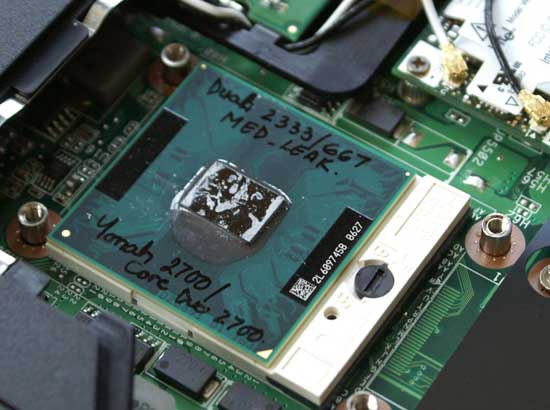
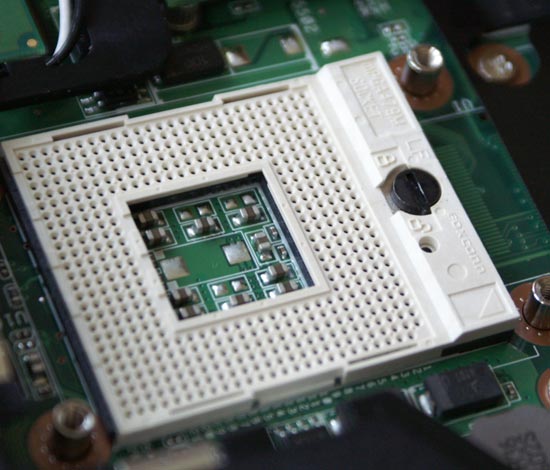
Today's article is a direct comparison between Intel's Core Duo and Core 2 Duo, since we're using the exact same platform for both. We just recently received MSI's Turion 64 X2 notebook in house and will be working on a separate review of it for those of you curious about the new Turion 64 X2 CPUs. But today we're here to find out how much faster Core 2 Duo is than Core Duo in notebooks, and if we can expect battery life to change for better or worse.


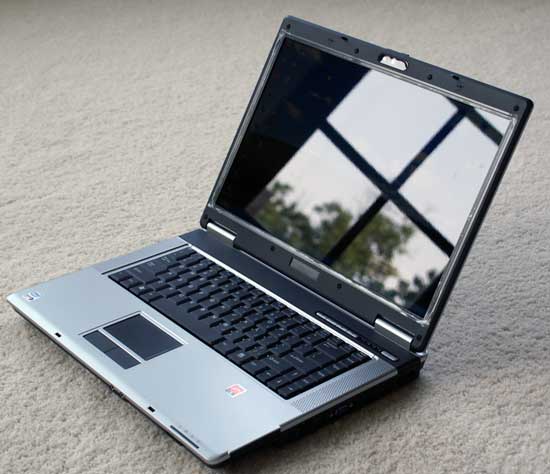

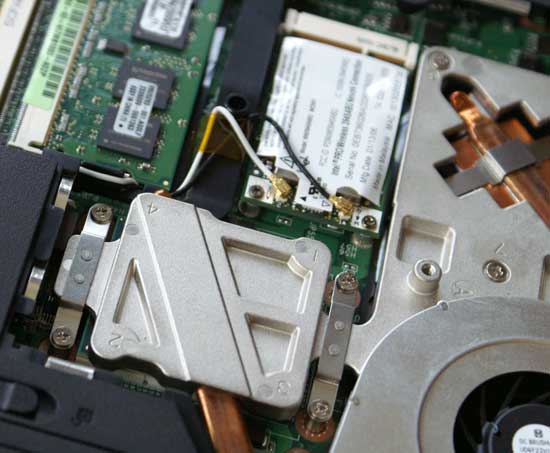
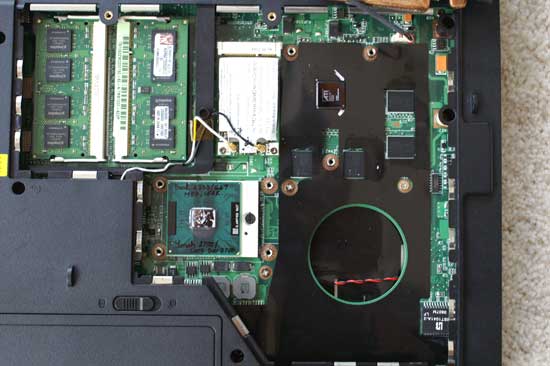








46 Comments
View All Comments
juanpoh - Friday, August 4, 2006 - link
Looking at http://www.intel.com/products/processor/pentiumm/i...">Intel Pentium M link, only 915 and 855 chipset is supported. However 945 chipset is listed as supported in http://www.intel.com/products/processor/celeron_m/...">Intel Celeron M link.jaybuffet - Friday, August 4, 2006 - link
I have the nx9420 notebook with the 945pm chipset... i was on hp support yesterday, and they said they would not support upgrading the CPU.. does that mean i am SOL because they wont upgrade the BIOS to support it?Pjotr - Friday, August 4, 2006 - link
Please correct the percentage numbers on http://www.anandtech.com/cpuchipsets/showdoc.aspx?...">http://www.anandtech.com/cpuchipsets/showdoc.aspx?..."17.5% increase in performance" -> "17.5 % less time used" OR "21.3 % increaase in performance"
Same mistake for all other time based benchmarks.
shecknoscopy - Thursday, August 3, 2006 - link
Given the nearly identical architectures of the desktop Conroes and the new Merom chips - how well do all of you think the two would stack up in a direct side-by-side comparison? This is open to blatant conjecture, of course, as the necessary hardware to <b>really</b> make a single-variable experiment isn't out there. But for those of us considering mobile-on-desktop options, how much of a performance cut would we see jumping from a Conroe to a Merom?IntelUser2000 - Saturday, August 5, 2006 - link
Intel mentioned something about having different prefetchers that match the market, meaning Woodcrest's Prefetchers are fit for workstation/server, Conroe for desktop, Merom for mobile applications(performance/battery life).
If you look at Core Extreme X6800 vs. Core 2 Duo E6700 benchmarks, you can see that in some reviews the differences are greater than the 267MHz clock difference(10% clock difference). Maybe Core Extreme has superior prefetchers to the Core 2 Duos, giving advantage in select few applications.
Sunrise089 - Thursday, August 3, 2006 - link
This was the exact question I just signed on to ask....so I await and answer as well.shecknoscopy - Thursday, August 3, 2006 - link
Woohoo! Great minds think alike, eh? Also, so do ours!JackPack - Thursday, August 3, 2006 - link
Which stepping did you use in this test? B1?EagleEye - Thursday, August 3, 2006 - link
I think the asus barebones configuration is mislabeled in this article. The s96j has the WXGA 1280x 800 screen while the z96j has the WSXGA 1680x 1050 screen. They either had an s96j or the native resolution is wrong as they stated it.Kalessian - Thursday, August 3, 2006 - link
I noticed that, too.